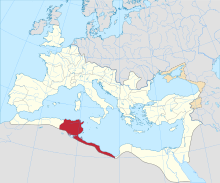Africa Proconsularis (125 AD) Semta was a Roman era Municipium also known as Augustum Semta in Africa Proconsularis that is tentatively identified with ruins at Henchir Zemba (Dzemda ) [ 1] Carthage , Tunisia near the Oued el Kebir 20 km (12 mi) southwest of Zaghouan [ 2] [ 3]
Ruins
The site has been excavated and those excavations revealed three different building complexes:[ 4]
a 40 m × 50 m (130 ft × 160 ft) rectangular building,
a 4 m (13 ft) high mausoleum and,
two further buildings, one of which is called the Byzantine fortress, measuring 40 m × 30 m (131 ft × 98 ft). Numerous inscriptions have been found there.[ 5]
Bishopric
The ancient city was also the seat of an ancient bishopric [ 6] ecclesiastical province of Carthage .[ 7] [ 8] [ 9] Council of Carthage (411) , as at that time the city had no Donatist bishops. Florenzio took part in the anti-Monothelite Council of Carthage (646) . The current bishop is Juan Gómez .[ 10] [ 11]
References
^ Brent D. Shaw, Sacred Violence: African Christians and Sectarian Hatred in the Age of Augustine
^ Barington Altas .^ "Semta, Henchir-Dzemda – Digital Atlas of the Roman Empire" .^ Semta, Henchir Dzemda .^ Louis Poinssot & Robert Lantier, Q. Geminius Sabinus, Princeps peregrinorum Comptes rendus des séances de l'Académie des Inscriptions et Belles-Lettres (1923) Vol 67, Num 3 pp. 197-201.
^ Semta at catholic-hierarchy.org.^ "Apostolische Nachfolge – Titularsitze" . Archived from the original on 2019-01-19. Retrieved 2016-12-21 .^ Semta at gcatholic.org (English)^ J. Mesnage, L'Afrique chrétienne , (Paris, 1912), p. 63.
^ Le Petit Episcopologe , Issue 127.^ Revue des Ordinations Épiscopales , Issue 1955, Number 71.
